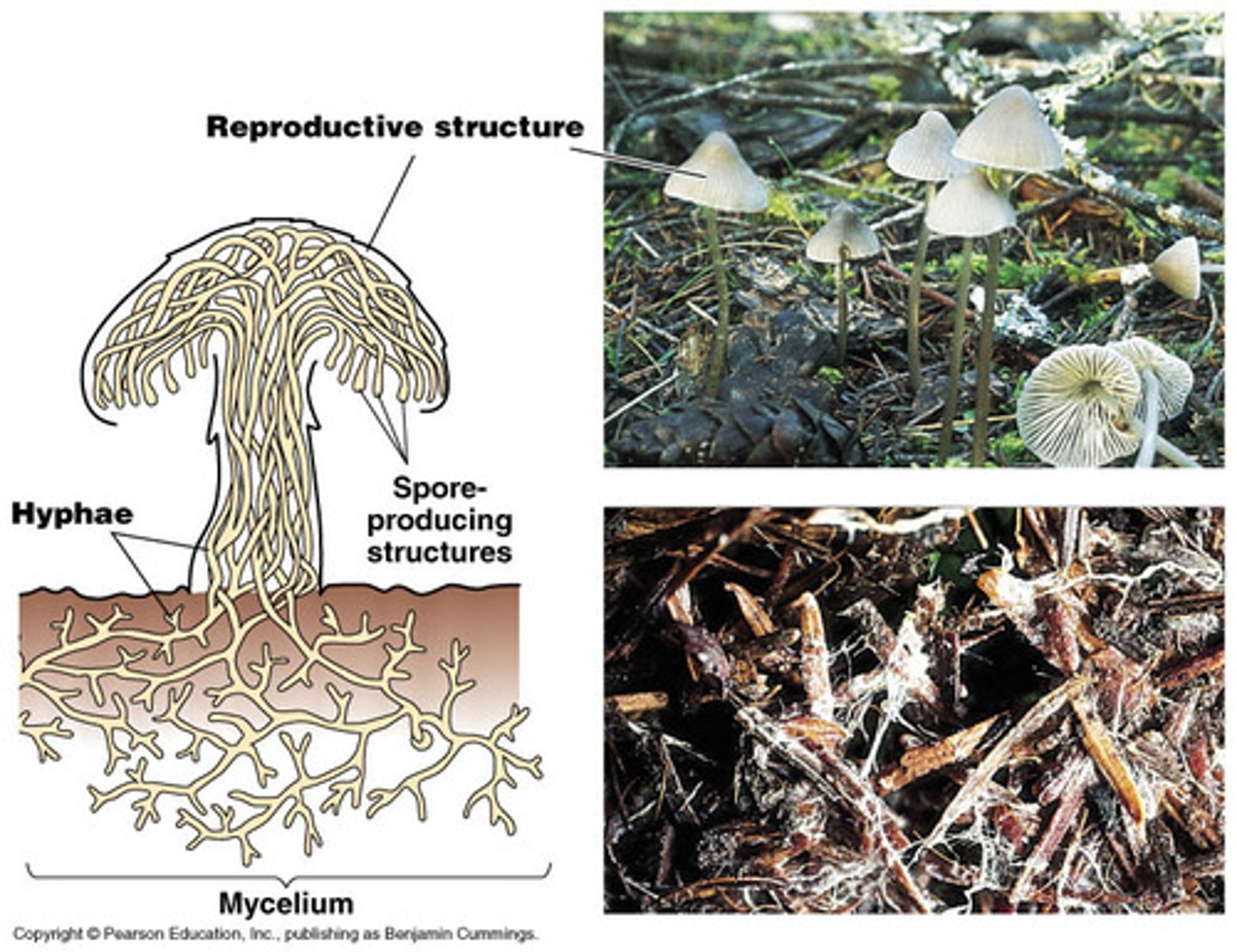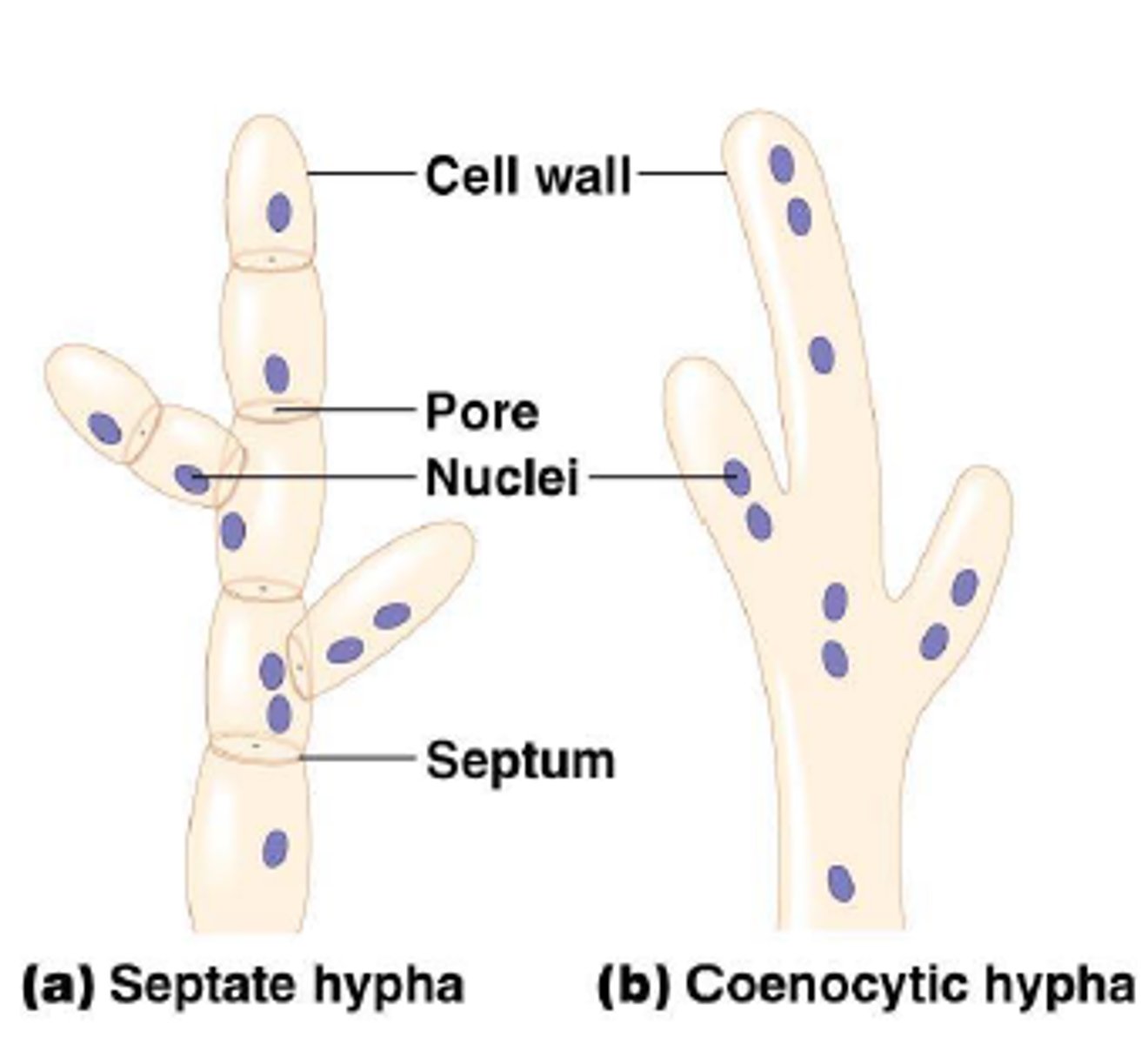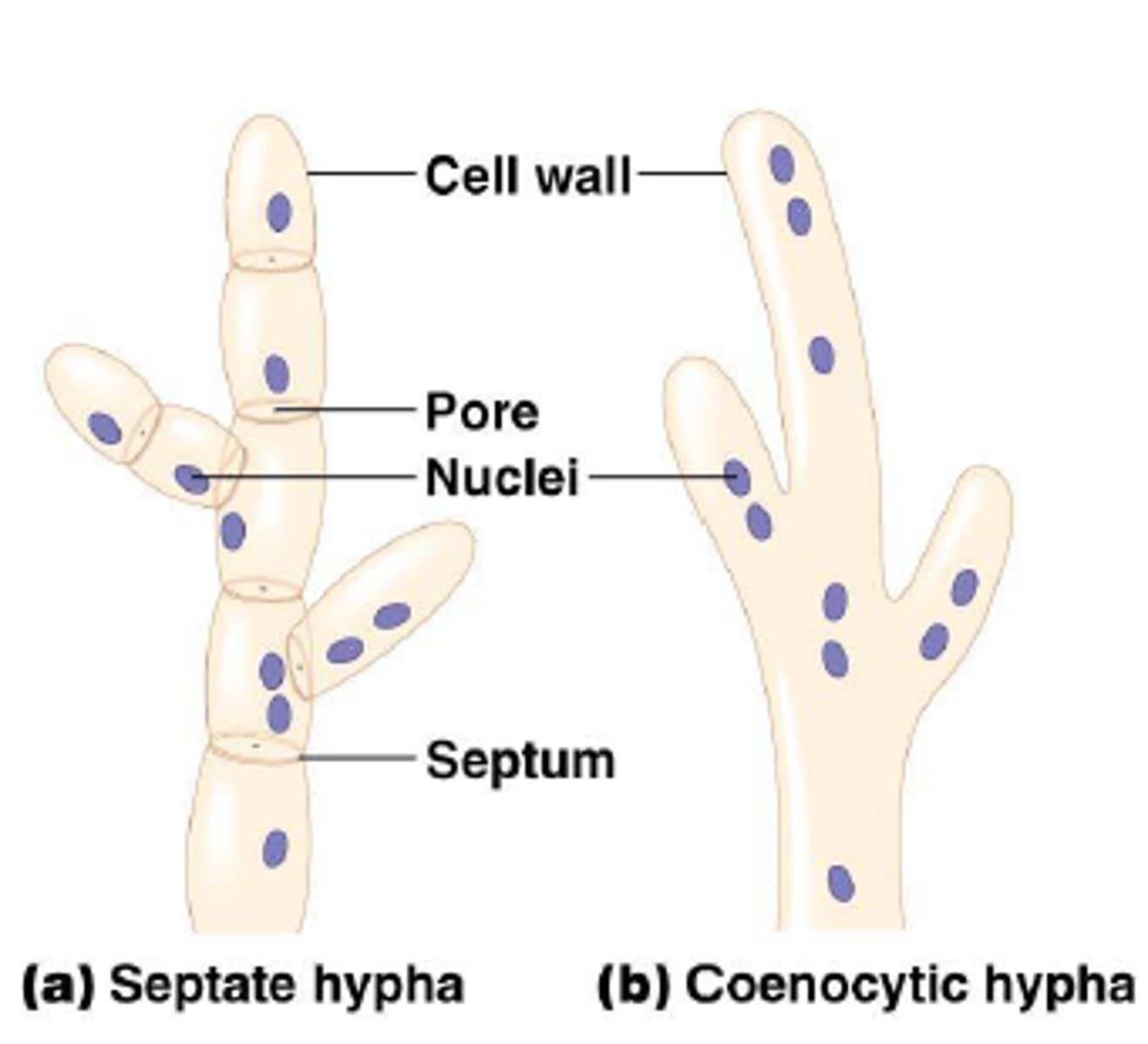BIOL 1113 (General Biology 2) Exam 2 Mary Susan Potts Santone
1/108
There's no tags or description
Looks like no tags are added yet.
Name | Mastery | Learn | Test | Matching | Spaced |
|---|
No study sessions yet.
109 Terms
Cilia
An organelle used for cell movement; lines the surface of the cell an beats in rhythmic waves to provide locomotion
Flagellum
A thin, threadlike structure on cells that provides locomotion by whipping back and forth; prokaryotic type spin, propelled by machines composed of a filament, hook, and motor
Binary fission
Asexual reproduction in which the fully grown parent cell splits into two halves, producing two new cells
Budding
Asexual reproduction in which a new organisms develops from a bud due to cell division at one particular site
Conjunction
Sexual reproduction where sex pilus forms between two cells; donor cell passes DNA to recipient through puilus
Transformation
Sexual reproduction that occurs then bacterium picks up free pieces of DNA from other prokaryotes
Transduction
Sexual reproduction when bacteriophages carry portions of bacterial DNA from one cell to another
Plasmid
Small, circular, double stranded, DNA molecule within a cell, separate from chromosomal DNA;
Endospore
Asexual spore that develops inside some bacteria cells; response to unfavorable reproduction conditions of cells
Obligate aerobes
Prokaryotes unable to grow in the absence of free oxygen
Obligate anaerobes
Prokaryotes unable to grow in the presence if free oxygen; these organisms can cause botulism, gangrene, and tetanus
Facultative anaerobes
Prokaryotes able to grow in either the presence or absence of oxygen
Autotroph
An organisms capable of synthesizing its own food from inorganic substances using light or chemical energy
Heterotroph
An organism incapable of manufacturing its own food and instead must obtain food and energy by taking in organic substances
Photoautotroph
An organisms that carries out photosynthesis to synthesize its own food
Chemoautotroph
Organisms that oxidizes inorganic compounds to obtain energy; reduces CO2 to use for organics it needs to synthesize
Saprotroph
Organism that feeds on or derives nourishment from decaying organic matter; decomposers
Symbiosis
A relationship between two or more organisms that live closely together; there are many types such as commensalism, parasitism, or mutualism
Commensalism
Symbiotic relationship where one benefits the other without affecting it
Mutualism
Symbiotic relationship where both organisms benefit
Parasitism
Symbiotic relationship where one organisms lives off and harms the other
Methanogen
Archaea that produce methane gas from H2 and CO2; may live in anaerobic marshes or ruminant (herbivorous) gut
Protist
Any eukaryotic organism that is not an animal plant or fungi; very diverse: some photoautotophic (many plankton), some heterotrophic, many symbionts, some pathogenic/parasitic; difficult to classify
Eukaryotes
Discoba, Land plants and relatives, Stramenopila, Alveolata, Amoebozoa, Rhizaria, and Opisthokonta are supergroups of what ?
Discoba
Euglenozoa, Kinetoplatids, and Metamonada are a part of what supergroup ?
Euglenoids
Small freshwater unicellular organisms; difficult to classify; have 2 flagellae and an eyespot; have chloroplasts surrounded by 3 rather than 2 membranes
Kinetoplastids and Metamonada
Colorless heterotrophs with unusual mitochondria; most symbiotic and many parasitic; well known for causing carious disease in humans
Kinetoplastids
Trypanosomes (African sleeping sickness) and Leishmania are types of what class of eukarya?
Metamonada
Giardia lamblia (common flagellate in digestive tract) and trichomonas vaginalis (sexually transmitted protist) are types of what class of eukarya?
Land plants and their relatives
Green algae, red algae, haptophytes, and the Kingdom Plantae are a part of which eukaryotic supergroup?
Stramenopila
Brown algae, diatoms, and water molds are a part of which eukaryotic supergroup ?
Alveolata
Ciliophora, Dinozoa, and Apicomplexa are a part of which eukaryotic supergroup?
Amoebozoa
Amoeboids and slime molds are a part of which eukaryotic supergroup?
Rhizaria
Foraminiferans, Radiolarians, and Chlorarachniophyta are a part of which eukarytoic supergroup ?
Opisthokonta
Chanoflagellates and Kingdoms Animalia and Fungi are a part of which euaryotic supergroup ?
Green Algae
Member of the phylum Chlorophyta, this classification of organisms are found in a variety of environments; majority are unicellular, but many are filamentous or colonial; some are multicellular and resemble leaves of lettuce; some symbiotic with fungi, plants, or animals.
Red Algae
Member of the phylum Rhodophyta, this classification of organisms are multicellular, found in marine environments, and are of great economic importance for their use in things such as agar, carrageenan, and sushi
Brown Algae
Member of the supergroup Stramenopila, this classification of organisms often live in cold ocean waters along rocky coasts; never unicellular and can come in small simple form or large forms that may exceed 200m in length; seaweeds, kelp, rockweed, holdfast, stipe, blade, air bladder,
Diatom
Member of the supergroup Stramenopila, this classification of organisms are the most numerous unicellular algae in the oceans; they make up a significant portion of phytoplankton; cell wall constructed of two valves (larger valve acts as lid) and cilia
Dinozoa
Member of the supergroup Alveolata, this classification consists of aquatic and marine unicellular organisms; they have cells bounded by protective cellulose plates and have two flagella;
Ciliophora
Member of the supergroup Alveolata, this classification of organisms are among the most complex of the protozoans: have hundreds of cilia beat in coordination, most are holozoic (swallow food whole), divide in asexual reproduction, have two nuclei of differing types (micronucleus: heredity; macronucleus: metabolism)
Apicomplexans
Member of the supergroup Alveolata, this classification of nonmotile obligate parasites (move around in spore state) contain apical complex of organelles on mesozoites/sporozoites; are parasites and one species causes Malaria, another causes toxoplasmosis
Plankton
Microscopic organisms drifting or floating in the sea of fresh water, consisting chiefly of diatoms, protozoans, small crustaceans, and the eggs and larval stages of larger animals; Many animals are adapted to feed on these organisms.
Amoeboids
Members of the supergroup Amoebozoa, these organisms move and ingest their food with pseudopods; Entamoeba histolytica is a parasite of the human colon; Naegleria fowleri causes primary amoebic meningoencephalitis
Foraminiferans and Radiolarians
Members of the supergroup Rhizaria, these two classifications of organisms both have skeleton of either calcite or silica
Choanofagellates
Members of the supergroup Opisthokonta, this classification of microscopic organisms are found in marine and fresh water environments, can be solitary or colonial, attached or free swimming, and have single flagellum surrounded by collar of microvillia
Modes of nutrition
(look in lab book)
Spore
Unit of sexual or asexual reproduction that may be adapted for dispersal and for survival until finding a suitable habitat to grow
Life cycle of Plasmodium vivax
Asexual reproduction
Type of reproduction by which offspring arise from a single organisms and inherit the genet of that parent only
Sexual reproduction
Type of reproduction by which organisms combine genetic information from two individuals of different sexes
Conjugation
The temporary union of two bacteria or unicellular organisms for the exchange of genetic material
Red tide
Tremendous concentrations of dinoflagellates in the water collumn
Zooxanthellate
Symbiotic dinoflagellates in corals
Paralytic shellfish poisoning
When toxins from dinoflagellates affect organisms higher up the food chain than the filter-feeders that ingest dinoflagellates, especially effects humans who may eat shellfish
Paramecium
Ciliates that partake in conjugation where the macro nucleus will degenerate and the micro nucleus with replicate through meiosis; when the paramecium conjugate, the organisms will swap micro nuclei and one will become the new macronucleus
Haploid life cycle
Life cycle where haploid cells turn into gametes, gametes fuse to form diploid zygote that undergoes meiosis to produce many haploid cells; occurs in organisms like volvox, dinoflagellates, sporozoans, and trypanossomes; organisms that we recognize are in their haploid state
Sporic/alternation of generations (life cycle)
Life cycle where in the course of the cycle we see two multicellular individuals, sporophyte (diploid) and gametophyte (haploid) generations;
a gametophyte gametes fuse into diploid zygote, which becomes a diploid sporophyte that produces a sporangium where meiosis occurs and produces haploid gametophyte spore; green plants, algae, and foraminiferans
Diploid life cycle
Life cycle where we recognize the diploid individual; haploid gametes fuse into diploid zygotes that undergo lots of mitosis; Animals, green algae, diatoms, ciliates
Fungi
Sapotrophic decomposers that include mushrooms, mildew, mold, morels, and yeasts
Osmotrophy
Uptake of dissolved organic compounds by osmosis for nutrition
Thallus
A plant body that is not differentiated into stem and leaves and lacks true roots and a vascular system
Mycelium
Fungal body composed of vast network of thread-like filaments called hyphae

Aseptate fungi
Type of fungi with hyphae that is not partitioned by septa; multinucleated

Septate fungi
Type of fungi with hyphae that is partitioned by septa (cross walls); ascomycota (sac fungi) basidiomycota (club)

Hyphae
A branching filament that make up the mycelium of a fungus

Chitin
A polysaccharide that makes up the cell walls of fungi
(Fungal) sexual reproduction
Way that fungi reproduce which involves four different stages: haploid hyphae, dikaryotic stage, diploid zygote, spores
(Fungal) asexual reproduction
Way that fungi reproduce that involves sporangium and zygospores
Bread molds (zygospore fungi)
Type of fungi, mainly saprotrophs that decompose animal and plant remains; some parasites of soil protists worms and insects; ie black bread mold
Sac fungi (Ascomycota)
Type of fungi, ascomycetes, mainly saprotrophs that digest resistant materials containing cellulose, lignin, or collagen; septate hyphae; produce asci, ascospores, and ascocarps; produce dikaryotic mycelium with two kinds of nuclei; ie neurospora, morels and truffles, yeasts, penicillin
Yeast
Term loosely applied to unicellular fungi, many of which are ascomycetes; budding common form of asexual reproduction; when these organisms ferment they produce ethanol and CO2
Club fungi (Basidiomycota)
Type of fungi, basidiomycetes, with mycelium composed of septate hyphae; hyphae contain complex pores and produce diverse fruiting bodies; causes plants diseases- smut and rests; ie toadstools, mushrooms, puffballs, stinkhorns
Lichen
Group of organisms that exists as a symbiotic association between a fungus and a cyanobacteria or a green algae; 3 morphological types - crustose, fruticose, foliose
Mycorrhizae
Group of organisms that exists in a mutualistic relationship between soil fungi and roots of most familiar plants; give plants greater absorptive surface and help them obtain more nutrients;
Sporangium
A single-celled or many-celled structure in which spores are produced, especially in fungi, algae, mosses, and ferns
Zygospore
A thick-walled diploid or multinucleate spore formed by the union of similar gametes in certain fungi and algae.
Conidiospore
A small, usually single-celled reproductive body that is capable of developing into a new individual without sexual fusion; sexual spore formed after the fusion of gametes
Basidia
Spore-producing cell shaped like a club found on the fruiting bodies of basidiomycete fungi, basidiocarps.
Viral envelope
A structure enclosing a viral capsid that consist of a membrane derived from the plasma membrane of of the host cell; embedded with virally encoded spike glycoporteins
Basidiospore
Haploid spore produced by the basidium of a fungi; these spores develop into a mycelium that fuses with another to form a dikaryotic mycelium that makes the macroscopic stage of the life cycle
Attachment
step of a viral reproductive cycle where the virus attaches to the surface of a host cell
Entry
step of a viral reproductive cycle where the viral genome enters the host cell
Integration
step of a viral replication cycle where the enzyme integrase cuts into the host's chromosomal DNA and inserts the viral genome into the chromosome; only done by viruses capable of integration
Provirus
Viral DNA that has become incorporated into eukaryotic chromosome
Biosynthesis
step of viral replication cycle where the production of new viruses by a host cell involves the replication of the viral genome and the synthesis of viral proteins that make up the protein coat
Assembly
The assembly of new viruses after the synthesis of necessary components
Release
step of the viral reproductive cycle is the release of new viruses from the host cell; aka lysis
Temperate phage
Bacteriophage that can follow both lysogenic and lytic cycles
Virulent phage
Phage that follows only the lytic cycle
Nitrogen fixation
Conversion of N2 into NH3 used by certain prokaryotes; done using enzyme nitrogenase
Microbiome
All of the microorganisms in a particular environment
Mucilage
slimy coat on bacteria, sometimes called glycocalyx or capsule; composed of hydrated polysaccharides, proteins, lipids, and nucleic acids
Endosymbiosis
Process in which one species, the endosymbiont, lives in the body or cells of another species, the host; such close proximity increases the odds for gene exchange between distantly related species
Pili
Short threadlike cell surface structures used by some prokaryotes for gliding motions; looks similar to cilia, but are composed of different proteins
Primary endosymbiosis
When eukaryotic host cells acquire prokaryotic endosymbionts; ie mitochondria in cells
Alveolata
Protist supergroup named for saclike membranous vesicles known as alveoli that are present at the cell periphery;
Discoba
Protist supergroup of unicellular flagellates; often with feeding groove and uses phagocytosis to ingest food; disc-shaped mitochondrial cristae
Stramenopila
Protist supergroup named for distinctive strawlike hair that occur on the surfaces of flagella; usually produces flagellate cells at some point in their lives;
Rhizaria
Protist supergroup that include groups of flagellates and amoebae that have think pseudopodia